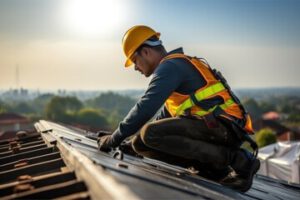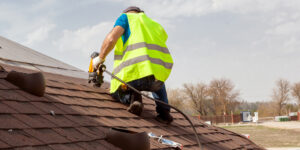Roofers, also known as roof mechanics or roofing contractors, are tradespeople that specialize in constructing and installing roofs. They are a vital part of any construction project.

In most climates, their work is seasonal and they may spend months at a time without work. They are often required to attend training and safety meetings on a regular basis.
Roofers are tradespeople specializing in the construction and maintenance of roofs. They work on different materials, including shingles, EPDM, and metal panels. They also inspect and repair damaged structures and determine the cost of repairs. Those who choose to become roofers should be comfortable working at heights and using a variety of tools and equipment. They must be able to provide customers with accurate estimates for their services.
A career as a roofer is an excellent choice for people who want to do meaningful work. However, this job is quite tiring and requires a lot of standing and hammering. It is also important to be in good physical shape since the physical demands of roofing are very high. Furthermore, roofers often come home exhausted and do not have enough energy to engage in social activities with their loved ones. This can lead to serious health problems in the long run.
Typically, roofers receive on-the-job training from experienced roofers before they are qualified to perform their duties. They begin by assisting their trainers in carrying equipment and materials and erecting scaffolding. As they gain experience, they can replace the shingles on roofs and install new insulation. In addition, they can also repair leaking roofs and install vapor barriers.
Roofers can also work on different types of buildings, such as residential and commercial structures. They can re-slate and tile roofs and fit skylight windows. In addition, they can replace lead sheeting and cladding. Roofers also spray roofs, sidings, and walls with materials that bind, seal, insulate, or soundproof sections of structures.
Roofers are in high demand for their skills and knowledge. This profession can be lucrative and satisfying, but it is also risky. Many roofers suffer from back problems and spine issues due to the repetitive nature of their jobs. Additionally, the low salary of roofers makes it difficult to afford proper medical care when needed. This can be problematic, especially as they get older and are no longer able to work. Moreover, they may lose their homes if they are not able to pay their mortgages and other bills.
Training Requirements
The roof is a vital part of any building, and roofers are responsible for installing, repairing and maintaining them. They work in challenging and sometimes dangerous conditions, so they must have the right physical strength, stamina, and attention to detail. They also must be able to work well with other construction workers and customers. In addition, they must be familiar with various tools and materials used in the roofing industry.
Most roofers learn through on-the-job training or an apprenticeship program. They usually start as helpers, and gradually gain more responsibilities as they learn the trade. Some apprentice programs last up to five years. During this time, they receive a wage as they train on the job. In addition, they take 144 hours of classroom instruction per year in subjects such as tool use, safety, and math.
Some states require that roofers have a commercial general liability insurance policy, pass an examination and in some cases obtain a license before they can begin work. Similarly, some unions also have their own requirements for becoming a roofer. For instance, the United Union of Roofers, Waterproofers and Allied Workers has an apprenticeship program that takes three years to complete. During this time, apprentices are paid a salary and attend classes for 144 hours each year.
Training for roofers is important because it helps to improve their skills and allows them to perform a better quality of work. The National Roofing Contractors Association (NRCA) provides courses that provide an industry-recognised qualification. These qualifications can be useful when demonstrating to potential employers or clients that the roofing worker is capable of carrying out roofing works to a recognised standard.
Roofers must be able to read blueprints, understand the different types of roofs and materials, and have good math skills. They must also be able to estimate the cost of a new roof or repair an existing one. Additionally, they must be able to follow detailed instructions and be able to work in teams. Having the right skills is important because it will make it easier for them to find work and be successful in their career.
Working Conditions
Roofers must be comfortable working in a physical work environment, often exposed to harsh weather conditions. They need to be able to stand for long periods of time and also have the ability to bend, squat, and climb. Depending on the location and type of roofing job, roofers may need to wear protective clothing such as hard hats, goggles, and thick gloves. This equipment is necessary to help prevent injuries on the job site, which are common for this profession. Injuries related to falling, heat exposure, and repetitive motion are common among roofers. Thousands of these hardworking professionals are subjected to injury and death each year, which is why proper safety protocols must be adhered to at all times.
Roofers frequently collaborate with other construction professionals such as carpenters, electricians, and plumbers on a project. This requires good communication skills and customer service abilities. They need to be familiar with the specifications of a variety of roofing materials and how they are installed. This knowledge is essential for ensuring that a roof is constructed correctly and can withstand different environmental elements.
Those who specialize in shingle roofs, for example, need to know the correct procedures and tools for installing these types of roofing systems. They also need to be able to handle heavy bundles of shingles that can weigh up to 60 pounds. In addition, they need to be unafraid of heights since much of their work is performed at a considerable elevation above the ground.
In addition to shingle roofs, some roofers specialize in flat or low-slope roofing systems that are used on commercial buildings. These require specialized skills and techniques that differ from those of shingle roofs. Others may focus on the installation of solar panels, which can significantly reduce a building’s energy costs.
While employment for roofers is expected to grow as fast as the average for all occupations, workers may need to be willing to relocate to find work. This is because the demand for this occupation varies by region. Demand is driven by the need to repair or replace existing roofs and the construction of new homes and buildings.
Salary
A roofer’s salary depends on many factors, including his or her experience and education level. Those with more advanced degrees will normally make a higher income. However, the type of work done will also determine how much a person earns. For instance, roofing professionals that work in hurricane-prone states or urban areas generally earn more than those working in rural or mountainous regions.
Some roofing professionals will choose to work overtime, but most stick to the standard 40 hours per week. In addition, some roofers will work for a contracting company while others will start their own business. Regardless of the choice, the benefits of this job include a varied and rewarding career path as well as more stability than other trade jobs.
In terms of the work environment, roofing professionals will normally be exposed to a lot of dust and dirt. This can be bad for a person’s health as it will affect his or her lungs and may cause eye problems. In order to protect themselves from the dust, roofers should wear protective clothing and equipment at all times.
It is also worth noting that many people in this profession don’t have good health insurance and they may lose their job if they suffer from serious illnesses. This can be a huge problem, especially for families as it will lead to them losing their home and they might not be able to afford medical treatment.
Another disadvantage of this profession is that it can be quite stressful and tiring due to the physical nature of the job. Some of the work can also be dangerous and the risk of injuries is high. In addition, it is essential that roofers have proper insurance so they can be covered if they are injured. Finally, if the roofers fail to obtain proper permits for their work, they could be fined by local authorities. This can be a costly mistake for the homeowner who could then have to pay for expensive repairs.



